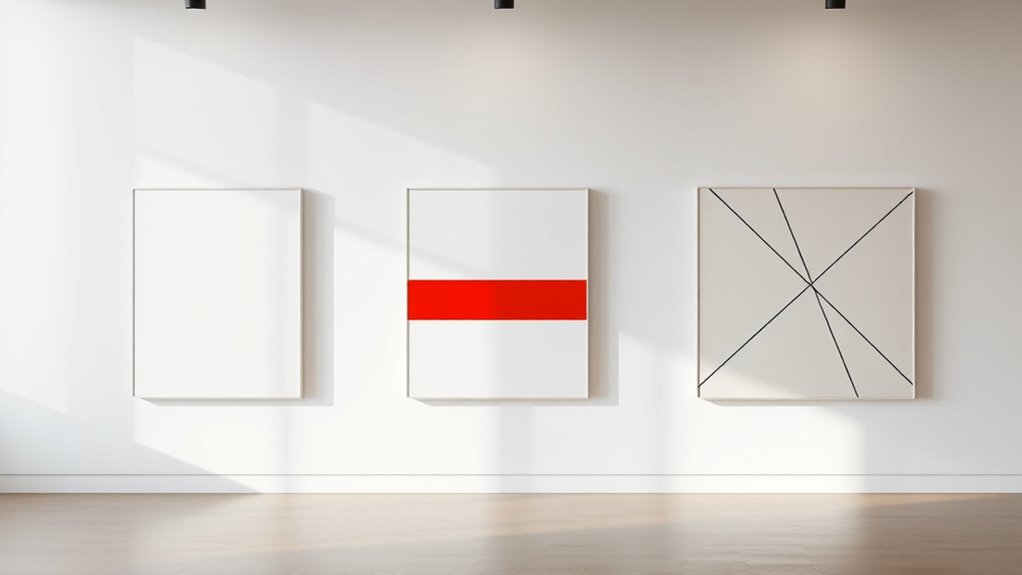The evolution of minimalism in fine art shifts from reacting against complex, expressive styles to embracing simplicity and essential forms. You’ll see how artists like Judd and Flavin used industrial materials, clean lines, and repetition to focus on space and form. digital innovations now expand minimalism into immersive environments and interactive works. As minimalism reflects broader societal moves toward clarity and sustainability, exploring further reveals how it continues to shape contemporary art.
Key Takeaways
- Minimalism emerged in the mid-20th century as a reaction against complex, emotionally intense art movements, emphasizing simplicity and essential forms.
- Artists adopted industrial materials, geometric abstraction, and precise compositions to focus on form, space, and visual clarity.
- Contemporary practices incorporate digital media, interactive installations, and generative algorithms, expanding minimalist expression into virtual realms.
- Cultural shifts toward mindfulness and sustainability have influenced minimalist art, promoting intentional living and environmental responsibility.
- Future directions explore eco-friendly materials, immersive virtual environments, and philosophical questions about beauty, meaning, and human connection.
Origins and Foundations of Minimalist Art

Minimalist art emerged as a reaction against the complexity and emotional intensity of previous art movements, focusing instead on simplicity and essential forms. You’ll notice this shift in how artists employ color theory, choosing limited palettes to evoke mood and harmony with minimal distraction. Geometric abstraction plays a significant role, as artists favor clean lines, shapes, and precise compositions that emphasize form over detail. This approach strips art down to its core, encouraging you to focus on spatial relationships and visual balance. Minimalism rejects ornate ornamentation, instead highlighting the power of basic geometric shapes and subtle color variations. By doing so, it creates a sense of clarity and calm, inviting you to experience art on a direct, visceral level without the clutter of traditional symbolism or complexity. An understanding of artistic principles enhances appreciation of how minimalism emphasizes form and space over elaborate detail.
Key Artists and Movements Shaping Minimalism
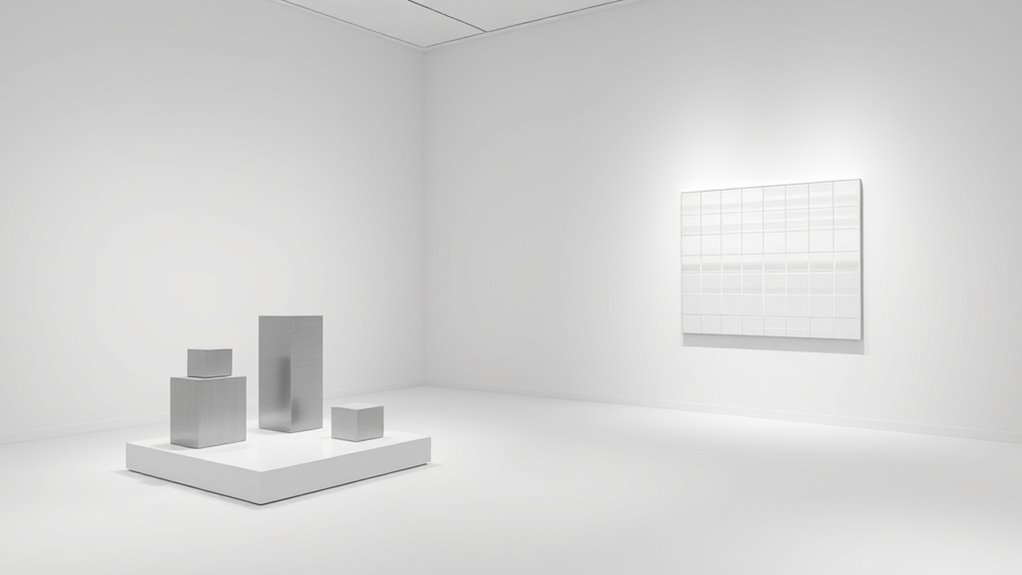
You’ll want to explore how artists like Donald Judd and Dan Flavin revolutionized minimalism with their emphasis on simplicity and space. Major movements, such as the Minimalist sculpture and geometric abstraction, played a pivotal role in shaping the movement’s direction. Their techniques and styles, characterized by clean lines and industrial materials, continue to influence contemporary art today. Additionally, the use of essential oils in various applications reflects a modern appreciation for purity and natural simplicity that echoes minimalist principles.
Pioneering Artists’ Contributions
Several pioneering artists and movements played a crucial role in shaping the development of minimalism in fine art. Artists like Donald Judd and Dan Flavin focused on simplicity, emphasizing form and material. Agnes Martin explored subtle variations in color theory, creating calming, geometric works. Performance art also influenced minimalism, pushing boundaries beyond traditional painting. These artists challenged viewers to contemplate space, perception, and the essence of art itself. Their contributions helped shift focus from emotional expression to pure form and experience. The table below highlights key figures and their impact:
| Artist | Contribution | Notable Work |
|---|---|---|
| Donald Judd | Sculptural minimalism | Untitled (Stack) |
| Agnes Martin | Subtle color and geometric forms | The Tree |
| Dan Flavin | Light installations | Monuments for V. T. |
Major Minimalist Movements
Building on the innovative ideas of pioneering artists, major minimalist movements emerged in the mid-20th century, shaping the direction of contemporary art. You’ll notice how artists embraced geometric simplicity, creating works with clean lines and basic shapes that emphasize form over content. These movements often favored monochromatic palettes, stripping away unnecessary detail to focus on pure visual experience. The Minimalist Movement, led by figures like Donald Judd and Dan Flavin, prioritized industrial materials and repetitive forms, emphasizing objectivity. Similarly, the Geometric Abstraction movement, with artists like Frank Stella, explored precise shapes and uniform colors. These movements revolutionized how you perceive space and form, encouraging a focus on the fundamental elements of art and fostering a sense of calm and clarity. Additionally, the movement’s emphasis on attention to detail influenced both artistic practices and viewer perception, fostering a deeper appreciation for simplicity.
Artistic Techniques and Styles
Artists shaping Minimalism employed specific techniques and styles that emphasized simplicity and precision. They focused on reducing forms to essential elements, often utilizing a limited color palette guided by color theory to evoke calm and clarity. Spatial composition played a vital role, with artists carefully arranging shapes and negative space to create balanced, harmonious works. Techniques like precise lines, flat surfaces, and uniform textures reinforced the minimalist aesthetic, drawing attention to fundamental visual components. Key figures, such as Donald Judd and Dan Flavin, explored repetition and industrial materials, emphasizing form over embellishment. These approaches fostered a sense of order and universality, allowing viewers to engage with the artwork’s pure essence without distraction. Additionally, ethical hacking techniques such as reconnaissance and scanning are employed to understand and analyze the security landscape, mirroring the meticulous planning and precision valued in minimalist art. Ultimately, their techniques shaped a movement rooted in clarity, restraint, and deliberate composition.
Material Innovations and New Techniques
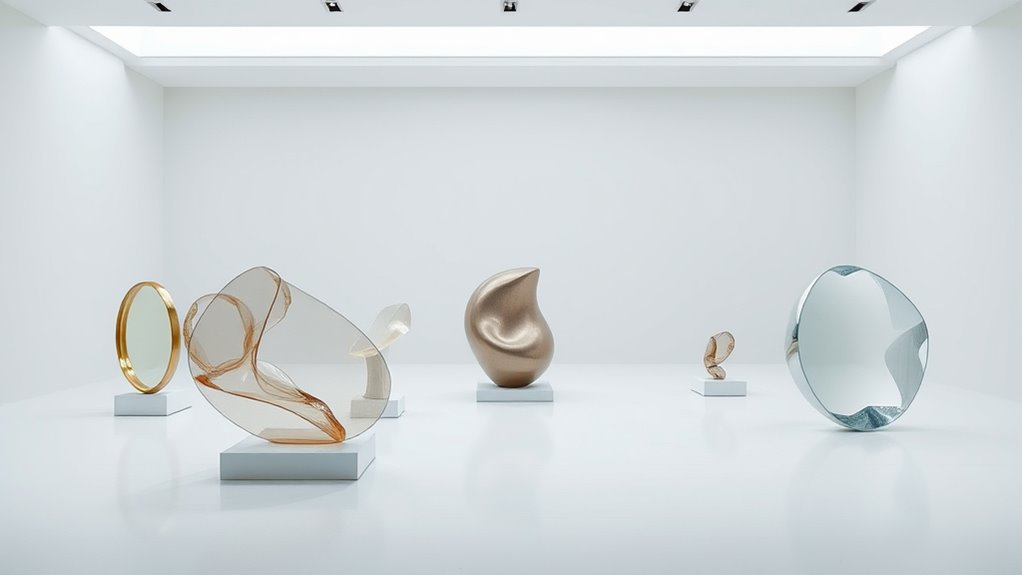
You’ll notice how artists experiment with new materials to push minimalism’s boundaries, using everything from industrial paints to unconventional substrates. Innovative painting techniques, like layering and surface manipulation, create fresh visual effects. Digital and mixed media also expand the possibilities, blending traditional and modern methods seamlessly. Additionally, some artists incorporate preppy aesthetic elements to add a touch of sophistication to their minimalist compositions.
New Material Applications
Innovations in materials and techniques have profoundly shaped the evolution of minimalism in fine art. You’ve embraced material experimentation, seeking fresh ways to express simplicity through new substances. Artists explore unconventional materials like industrial metals, plastics, and composites, pushing boundaries beyond traditional mediums. This approach allows for unique surface textures that enhance visual impact while maintaining minimalism’s essence. These material choices add depth and intrigue without clutter, emphasizing form and space. By applying innovative materials, you transform minimalist works into dynamic, engaging pieces. Your experimentation with surface textures highlights the tactile qualities of materials, reinforcing the idea that minimalism can be rich in sensory detail despite its pared-down aesthetic. Additionally, advances in material innovations enable artists to develop innovative techniques that further refine minimalist expression.
Innovative Painting Techniques
Building on the exploration of unconventional materials, contemporary painters are now pushing the boundaries of technique to further emphasize minimalism’s core principles. They experiment with innovative brushwork techniques to create subtle textures and precise lines that draw viewers’ focus. By applying color theory thoughtfully, artists select palettes that evoke emotion with minimal strokes, often using monochromatic or limited color schemes to enhance simplicity. Some incorporate controlled, deliberate brushwork to produce smooth, uniform surfaces, while others use impasto or scraping methods to add depth without clutter. These techniques challenge traditional notions of expression, favoring restraint and clarity. Additionally, understanding gear shifting techniques can inspire artists to consider how gradual adjustments create a sense of flow and harmony in their compositions. As a result, your approach to painting becomes more intentional, emphasizing the power of minimal gestures and carefully chosen hues to communicate complex ideas with economy.
Digital and Mixed Media
How are digital and mixed media transforming minimalism in contemporary art? You see artists now using interactive installations that emphasize simplicity while engaging viewers directly. These works often incorporate virtual reality, allowing you to immerse yourself in minimal environments that respond to your movements. This fusion of technology and minimalism pushes the boundaries of traditional forms, emphasizing experience over material excess. Digital tools enable artists to create subtle, refined visuals that evolve in real-time, enhancing the sense of immediacy and intimacy. Mixed media approaches combine physical and digital elements, fostering new forms of expression rooted in clarity and restraint. Ultimately, these innovations challenge you to rethink minimalism, not just as sparse aesthetics but as dynamic, participatory experiences enabled by evolving technological materiality.
Digital Age Influences and Contemporary Practices

The digital age has profoundly reshaped minimalism in fine art, enabling you to explore new forms of expression that emphasize simplicity through technology. Artists now use generative algorithms to create subtle, elegant visuals that evolve with minimal input. Virtual exhibitions give you access to minimalist works worldwide, breaking geographical barriers and offering immersive experiences. You might encounter:
- Interactive digital installations that respond to your presence
- Streamlined, code-based artworks emphasizing geometric purity
- Online galleries showcasing minimalist masterpieces in innovative formats
These contemporary practices push minimalism beyond traditional boundaries, highlighting clarity and essential form. Technology allows you to engage with art in dynamic, accessible ways, fostering a deeper appreciation of simplicity’s power. Relationships in the art community often foster collaboration and innovation, shaping how minimalism continues to evolve. The digital age continues to redefine how minimalism manifests, shaping its future in the art world.
Cultural Shifts and Minimalism’s Broader Impact
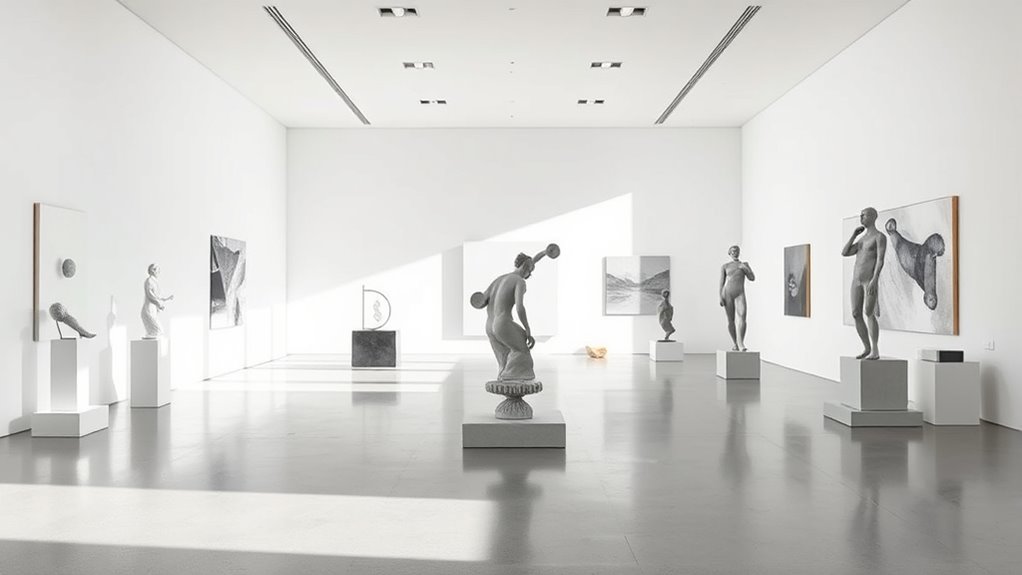
As technology continues to expand the reach of minimalist art, broader cultural shifts are shaping how society perceives and values simplicity. These shifts reflect a move toward clarity, mindfulness, and intentional living, influencing not just art but daily life. Minimalism’s broader impact is evident in how you prioritize quality over quantity, seek meaningful experiences, and reduce clutter—both physical and mental. This cultural embrace of minimalism encourages you to focus on essentials, fostering a sense of calm and purpose amid a fast-paced world. As perceptions shift, minimalism becomes more than an aesthetic; it’s a mindset that challenges consumerism and promotes sustainability. You’re part of a larger movement that values authenticity, intentionality, and the beauty of restraint, reshaping societal ideals around materialism and excess. Additionally, adopting principles from biodiversity awareness can inspire more sustainable and environmentally conscious lifestyles that align with minimalist values.
The Future Trajectory of Minimalist Aesthetics
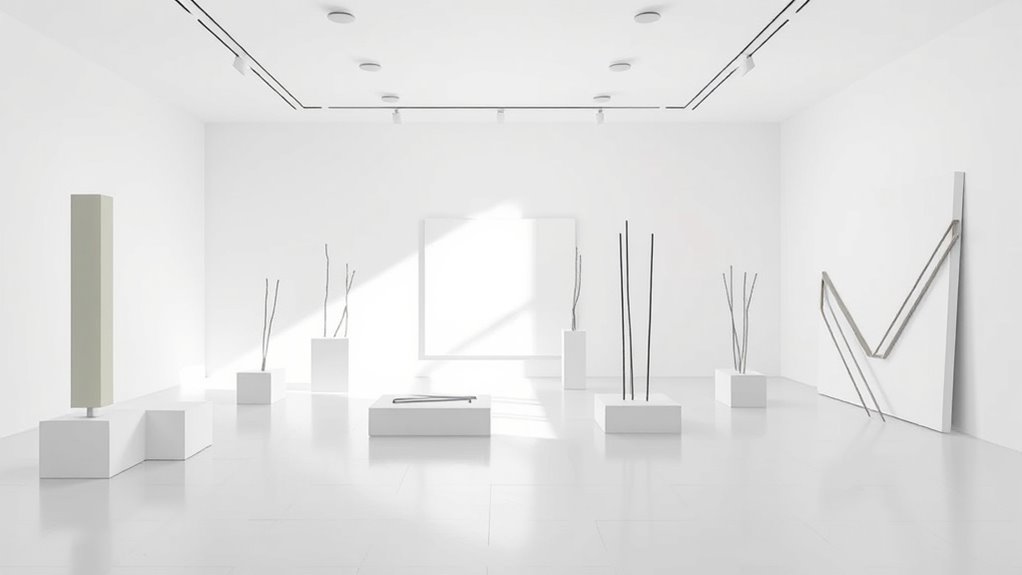
Looking ahead, the trajectory of minimalist aesthetics is poised to evolve alongside technological innovations and shifting cultural values. You’ll see artists explore new ways to express simplicity through digital media, interactive installations, and sustainable materials. Philosophical implications will deepen, prompting questions about the essence of beauty, meaning, and human connection in a world increasingly driven by technology. Environmental considerations will also shape future minimalist art, emphasizing eco-friendly practices and minimal resource use. Imagine:
Future minimalism merges technology, sustainability, and philosophy to redefine beauty and human connection.
- Digital artworks that adapt to viewer interaction
- Eco-conscious sculptures emphasizing sustainability
- Virtual reality experiences highlighting clarity and focus
- The integration of unique and wicked planters and other creative design elements to enhance immersive environments
These trends will challenge traditional notions of minimalism, blending innovation with core values of simplicity, functionality, and environmental responsibility. The future of minimalist aesthetics promises a dynamic, conscious evolution that reflects our changing world.
Frequently Asked Questions
How Does Minimalism Differ Across Various Global Cultures?
You’ll notice that minimalism varies across cultures, reflecting unique cultural expressions and influences. In some regions, it emphasizes simplicity and function, while others integrate spiritual or philosophical meanings into clean, sparse designs. This artistic diversity shows how minimalism adapts to local values, traditions, and aesthetics. By exploring these differences, you gain a richer understanding of how minimalism serves as a universal yet culturally specific artistic language.
What Role Does Minimalism Play in Contemporary Interior Design?
You might think minimalism is just about simplicity, but in contemporary interior design, it’s a powerful tool for transforming space utilization. It emphasizes a clean color palette that creates calm and focus, while carefully curated furnishings maximize function with fewer pieces. This approach invites you to experience your space more intentionally, revealing depth and tranquility through understated elegance. Minimalism’s role is to elevate everyday environments into serene retreats, balancing form and purpose seamlessly.
How Do Viewers Emotionally Respond to Minimalist Art?
When you view minimalist art, you often experience a unique emotional resonance that can evoke calmness, clarity, or introspection. Your perception is shaped by the simplicity and starkness, allowing you to focus on subtle details and your own reactions. Minimalist works encourage you to slow down and connect emotionally, fostering a sense of peace or contemplation. Your personal response varies, but the intentional sparseness invites deep, often profound, emotional engagement.
Are There Ethical Considerations in Minimal Art Production?
Thinking about the ethical considerations in minimal art production, you must consider authenticity concerns and environmental impact. You might wonder if artists truly create with integrity or if mass production compromises authenticity. Additionally, you should reflect on how minimalists minimize waste and reduce ecological footprints. Ethical art practices demand transparency, sustainability, and sincerity, ensuring that your choices respect both artistic integrity and the planet, fostering a future of responsible creativity.
Can Minimalism Influence Other Creative Disciplines Beyond Visual Arts?
You can see how minimalism influences other creative disciplines like minimalist music and architecture. In music, simple melodies and repetitive patterns create calming effects, while in architecture, clean lines and open spaces promote functionality and serenity. This approach encourages you to focus on essentials, stripping away excess to highlight core ideas. Minimalism’s emphasis on simplicity and clarity shapes diverse fields, inspiring innovative designs and compositions beyond visual arts.
Conclusion
As you explore minimalism’s journey, remember it’s more than just simple forms—it’s a mirror reflecting our desire for clarity amidst chaos. Its evolution shows how less truly can be more, transcending art to influence culture and technology. Embrace minimalism’s ongoing story, where each clean line and silent space invites you to find meaning beyond noise. After all, isn’t it in the absence that we often discover the most?
